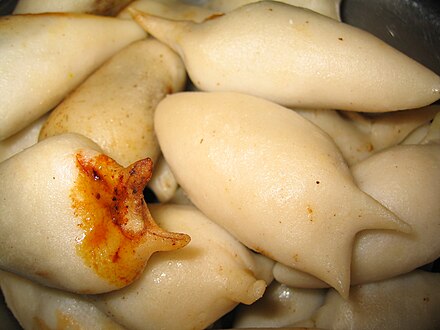Yomari




Yomari, also called yamari, (Nepal Bhasa: 𑐫𑑀𑐩𑐵𑐬𑐷 or 𑐫𑑅𑐩𑐵𑐬𑐷) is a delicacy of the Newar community in Nepal. It is a steamed dumpling that consists of an external covering of rice flour[1] with sweet fillings such as chaku and khuwa. The delicacy plays a very important role in Newa society, and is a key part of the festival of Yomari Punhi.[2][3] According to some, the triangular shape of the Yamari is a symbolical representation of one half of the Shadkona, the symbol of Saraswati and wisdom.[4]
Etymology
The name "yamari" comes from two Nepal Bhasa words, "Ya:"(𑐫𑑅) meaning "to like" and "Mari"(𑐩𑐵𑐬𑐷) meaning "delicacy/bread". So, yamari literally means a popular (liked) delicacy.
Festival
The festival of Yomari Punhi begins on the second day of the full moon when prayers are offered during which the yomaris are stored and not eaten. On the fourth and the final day the people belonging to the Newa community eat the sweet bread, seen as a gift from the gods, at the conclusion of the festival.[5]
See also
References
- ^ Goldstein, D.; Mintz, S.; Krondl, M.; Mason, L. (2015). The Oxford Companion to Sugar and Sweets. Oxford Companions. Oxford University Press. p. 634. ISBN 978-0-19-931339-6. Retrieved November 5, 2016.
- ^ Roufs, T.G.; Roufs, K.S. (2014). Sweet Treats around the World: An Encyclopedia of Food and Culture. ABC-CLIO. p. 237. ISBN 978-1-61069-221-2. Retrieved November 5, 2016.
- ^ Republica. "PHOTOS: Sweet Yomari". My Republica. Retrieved 2021-01-05.
- ^ Basu Pasa (बासुपासा). Kantipur (कान्तिपुर) (in Nepali).
- ^ Nepal Travel Guide
External links
- Yomari recipe